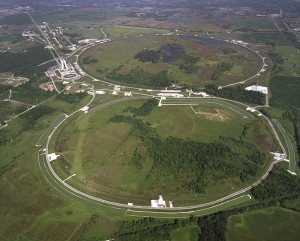The Tevatron is scheduled to close in 2011.
The U.S. government’s advisory panel on high-energy physics recommended today that Fermilab extend the run of its flagship particle collider if funding agencies can provide extra financial support.
"Given the strong physics case, we encourage the funding agencies to try to find the needed additional resources," the High Energy Physics Advisory Panel said in its report.
Fermilab's Tevatron, which had its first collisions 25 years ago, is scheduled to shut down in September 2011. The panel recommended continuing the run for an additional three years, provided funding agencies could increase annual funding for the field by about $35 million for four years.
The panel also recommended the laboratory make a strong effort to minimize the impact of an extended run on the NOvA neutrino experiment, which is under construction and scheduled to begin in 2013.
Continuing to run the Tevatron would delay an upgrade to the Fermilab accelerator complex needed to provide a more intense beam of neutrinos to the NOvA detector. This would hold the experiment back from reaching its full sensitivity for an additional two years. The panel proposed either trying to find a way to intensify the beam before the planned upgrade or increasing the size of the NOvA detector, allowing it to collect more neutrino signals.
Panel members advised against making significant alterations to the laboratory’s current scientific program, as guided by a 10-year plan they drafted in 2008. But they conceded that the hunt for the Higgs boson, which scientists theorize gives particles mass, is of such importance to the field that it would be worthwhile for the Tevatron to keep up the search.
The Large Hadron Collider, now the world’s largest particle collider, has also begun to search for the Higgs
. Panel members said that scientists would benefit from running experiments at the two colliders simultaneously.
“We do not see this as a horse race between the Tevatron and the LHC,” the panel report said. “The two colliders complement each other to paint a clearer picture than either alone.”
For example, Fermilab’s Tevatron can identify the Higgs boson as it decays into b and anti-b quarks. Experiments at the higher power LHC currently have a more difficult time spotting this type of process, as the proportion of the number of signals that camouflage b quark decays over the occurrences of b quark decays increases with the energy of the collisions. Instead, LHC experiments will begin looking for the Higgs boson in a complementary decay channel, in which the Higgs decays into two photons.
Although the Higgs search is the primary justification for an extended Tevatron run, an extension would allow scientists to make considerable improvements to other important measurements as well, the advisory panel said.







